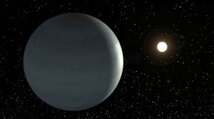 Впервые транзитным методом открыта "нормальная" планета
Впервые транзитным методом открыта "нормальная" планета

Так художник представляет себе экзопланету CoRoT-9b. Изображение Instituto de Astrofísica de Canarias
Международная группа астрономов впервые сумела обнаружить так называемым транзитным методом новую планету с параметрами, сравнимыми с параметрами планет Солнечной системы. Планета, получившая обозначение CoRoT-9b, расположена на расстоянии порядка 1500 световых лет от Земли в созвездии Хвост Змеи.



















Комментарии
В мире интересных фактов.
Оказывается Земля образовалась не 5.3 млдр.лет назад,а 65 миллионов лет раньше.
А не
!
Зато есть мёртвые свидетельства
http://www.ox.ac.uk/media/news_stories/2010/100318.html And yet the discovery of the most Earth-like exoplanet was announced in April . It is the first rocky world beyond our solar system that could hold liquid water. Just 1.5 times the size of Earth and possessing five times its mass
http://www.exoplanet.eu/papers/wasp11.pdf The method of transit has such disadvantages as: 1)The probability of a planetary orbital plane being directly on the line-of-sight to a star is the ratio of the diameter of the star to the diameter of the orbit. About 10%( or15%) of planets with small orbits have such alignment, and the fraction decreases for planets with larger orbits. The probability of a random alignment producing a transit is only 0.5% (and even somewhat less) for a planet orbiting a sun-sized star . However, by scanning large areas of the sky containing thousands or even hundreds of thousands of stars at once, transit surveys can in principle find extrasolar planets at a rate that could potentially exceed that of the radial-velocity method, although it would not answer the question of whether any particular star is host to planets. 2) And yet the method suffers from a high rate of false detections. A transit detection requires additional confirmation, typically from the radial-velocity method. So it turns out that the method has two drawbacks, and both are quite large. But this method also has certain advantages, one of which is considered important enough: The main advantage of the transit method is that the size of the planet can be determined from the lightcurve. This method one can apply jointly (often) with the radial velocity method (which determines the planet's mass) and as a result of that use one can determine the density of the planet, and hence learn something about the planet's physical structure. .
I think that this material can be offered here . This is not a long article, but interesting enough. :-http://arxiv.org/PS_cache/arxiv/pdf/0807/0807.4541v1.pdf ...There are few things that can excite not only astronomers.
Анонимные комментарии не принимаются.
Войти | Зарегистрироваться | Войти через:



Комментарии от анонимных пользователей не принимаются
Войти | Зарегистрироваться | Войти через:


